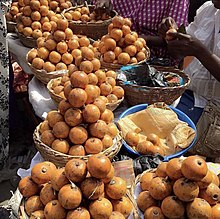| Gambeya albida | |
|---|---|
| Conservation status | |
 Near Threatened (IUCN 3.1) | |
| Scientific classification | |
| Kingdom: | Plantae |
| Clade: | Tracheophytes |
| Clade: | Angiosperms |
| Clade: | Eudicots |
| Clade: | Asterids |
| Order: | Ericales |
| Family: | Sapotaceae |
| Genus: | Gambeya |
| Species: | G. albida |
| Binomial name | |
| Gambeya albida (G.Don) Aubrév. & Pellegr. (1961) | |
| Synonyms | |
| |
Gambeya albida, commonly known as white star apple, is a forest fruit tree commonly found throughout tropical Africa. It is closely related to the African star apple (Gambeya africana) which is also common throughout West Africa. Some schools of thought feel that they may just be a variety of the same species. Also in the family is the purple star apple (Chrysophyllum cainito).

Amongst the Yoruba of Nigeria, it is called Agbalumo while it is called udala (udara) in the Igbo, Udari among the Efiks of Southern Nigeria with the usage of the latter term, coincidentally, also permeating across much of south-western Nigeria (i.e.,further east of Akoko-Ondo) the northern (Hausa-Fulani) parts of the country. The Hausa people refer to it as Agwaluma, a term they adopted from the Yoruba language, rather than "Agbalumo." This is because there is no African star apple native to Hausa Land. One local enduring sobriquet is derived from the Yoruba agbalumo, i.e., ‘agbaluma,’ and is used in certain parts of Nigeria.
The inherent sweetness of a child (or person of especially-seasoned cognisance/age who otherwise displays certain amiability-desirable characteristics representative of children and/or well-adjusted adults, e.g., well-roundedness, joviality, unassuming understanding) has been likened to the fruit in Igbo, as ‘udala nwannu.’
References
- ^ Hills, R. 2019. Gambeya albida. The IUCN Red List of Threatened Species 2019: e.T61961750A61961761. https://dx.doi.org/10.2305/IUCN.UK.2019-3.RLTS.T61961750A61961761.en. Accessed on 4 December 2022.
- ^ Gambeya albida (G.Don) Aubrév. & Pellegr. Plants of the World Online, Kew Science. Accessed 4 December 2022
- ^ Lost Crops of Africa: Volume III: Fruits. Washington, DC: The National Academies Press. 2008. p. 321. doi:10.17226/11879. ISBN 978-0-309-10596-5.
- Ibrahim, Aminu (4 February 2018). "Jerin muhimman kalmomin hausa 20 da ma'anar su a harshen turanci". legit.hausa.ng (in Hausa). Retrieved 18 January 2024.
- National Research Council. 2008. Lost Crops of Africa: Volume III: Fruits. Washington, DC: The National Academies Press. https://doi.org/10.17226/11879
External links
| Taxon identifiers | |
|---|---|
| Gambeya albida | |
| Chrysophyllum albidum | |
This Sapotaceae article is a stub. You can help Misplaced Pages by expanding it. |